The adoption of solar LED street lights for urban and rural infrastructure projects is rapidly increasing. As municipalities, businesses, and governments look for long-term savings and efficient solutions, evaluating both installation and maintenance costs becomes essential in making informed decisions. This article outlines the key factors to consider when assessing the costs associated with solar LED street lights.
Evaluating installation and maintenance costs is crucial to understanding the total cost of ownership for solar LED street lights and ensuring long-term performance and savings.
1. Introduction: The Importance of Evaluating Installation and Maintenance Costs
- Overview of the growing popularity of solar LED street lights for urban and rural infrastructure projects.
- Emphasize why evaluating both installation and maintenance costs is essential for governments, businesses, and municipalities seeking long-term savings and performance.
Search Intent: Users are looking for clear guidance on how to assess the total cost of ownership when choosing solar LED street lights, focusing on installation and ongoing maintenance.
2. Factors Influencing Installation Costs of Solar LED Street Lights
2.1 Site Assessment and Preparation Costs
- Explain how the location and environmental conditions can affect installation costs, including factors such as soil conditions, terrain, and proximity to existing power infrastructure.
- Discuss the need for site preparation, such as digging trenches for wiring, clearing obstructions, or reinforcing structures, and how these can impact overall costs.
Search Intent: Users want to understand how site-specific factors influence the cost of installing solar street lights.
2.2 Number of Units and Configuration Requirements
- Discuss how the number of solar LED street lights and specific configurations (e.g., pole height, light intensity, battery size) can impact installation costs.
- Mention how large-scale installations might benefit from bulk purchasing discounts, while smaller projects could incur higher per-unit installation costs.
Search Intent: Buyers want to evaluate how the size and scope of the project will influence installation costs, helping them plan their budgets accordingly.
2.3 Quality and Type of Equipment Used
- Compare different types of solar panels, LED lights, batteries, and controllers, and how the quality and brand of these components can affect installation costs.
- Highlight how choosing high-quality, more durable components might come with a higher upfront cost but result in lower long-term maintenance expenses.
Search Intent: Users are interested in understanding how the quality of equipment influences both initial installation and long-term costs.
2.4 Labor and Installation Time
- Break down the labor costs involved in the installation process, including the need for specialized technicians for solar panel setup, wiring, and testing.
- Discuss how installation time may vary depending on the complexity of the project and whether the site is easy to access or requires special equipment.
Search Intent: Users want to understand how labor costs, installation time, and specialized skill requirements contribute to overall installation expenses.
3. Evaluating Maintenance Costs for Solar LED Street Lights
3.1 Routine Maintenance and Inspection
- Outline the basic maintenance tasks needed to ensure solar LED street lights operate efficiently, such as cleaning solar panels, checking battery health, and inspecting for any physical damage.
- Discuss the frequency of routine inspections, which could be done quarterly or semi-annually, and how often these tasks are needed based on environmental factors (dust, rain, etc.).
Search Intent: Users are looking for information on the expected ongoing maintenance tasks for solar LED street lights and how often they need to be carried out.
3.2 Battery and Component Replacement
- Highlight the importance of battery longevity and replacement costs. Discuss the average lifespan of solar batteries (typically 5–10 years) and when replacements are necessary.
- Include information on the costs of replacing other components, such as LED bulbs and controllers, which may have a longer lifespan but still require occasional replacement.
Search Intent: Buyers want to know how often and how much they will need to invest in battery replacements and other component updates to ensure long-term operation.
3.3 Repairs and Fault Diagnosis
- Explain the cost implications of diagnosing and repairing faults in solar LED street lights, such as issues with wiring, faulty solar panels, or malfunctioning controllers.
- Discuss the advantages of remote monitoring systems in diagnosing issues early, which can reduce repair costs by identifying problems before they require extensive work.
Search Intent: Users are seeking to understand potential repair costs and the benefits of technology in reducing these costs through early fault detection.
3.4 Advanced Features Reducing Maintenance Costs
- Discuss how advanced features such as smart sensors, remote monitoring, and IoT integration can minimize maintenance costs by enabling predictive maintenance and reducing the need for on-site visits.
- Highlight how smart systems can alert municipalities or businesses to potential problems before they become costly repairs.
Search Intent: Users are interested in how modern technologies like remote monitoring and automation can lower maintenance costs and extend the lifespan of solar street lights.
4. Total Cost of Ownership (TCO) for Solar LED Street Lights
4.1 Calculating Upfront and Ongoing Costs
- Provide a detailed breakdown of the total cost of ownership, including initial installation, equipment, and labor, as well as ongoing maintenance, repairs, and replacements.
- Suggest using a TCO formula to calculate long-term costs and evaluate the overall financial benefits of solar LED street lights versus traditional lighting solutions.
Search Intent: Users want to calculate and compare the full cost of ownership for solar LED street lights, considering both the initial and ongoing expenses.
4.2 Comparing Solar LED Street Lights with Traditional Street Lighting
- Compare the total cost of ownership of solar LED street lights versus traditional electric street lights, considering energy consumption, maintenance, and replacement costs.
- Highlight the long-term savings that can be realized from solar LED lights, including reduced energy bills and lower maintenance requirements.
Search Intent: Buyers are comparing solar LED street lights to traditional lighting systems to evaluate the financial advantages over the long term.
5. Budgeting for Installation and Maintenance Costs
5.1 Planning for Future Replacements and Repairs
- Advise on how to budget for future component replacements and repairs, such as setting aside funds for battery or panel replacements every few years.
- Suggest establishing a maintenance reserve fund to manage unexpected repairs or upgrades.
Search Intent: Users are seeking guidance on how to plan and budget for long-term maintenance and replacement costs associated with solar LED street lights.
5.2 Financing Options and Incentives for Solar Street Lights
- Discuss available financing options, such as government grants, subsidies, or low-interest loans, that can help offset initial installation costs.
- Mention potential tax incentives or rebates for adopting solar technologies, which can further reduce the financial burden on municipalities or businesses.
Search Intent: Customers are looking for financial options or incentives that can help reduce the upfront cost of installing solar LED street lights.
6. Conclusion: Making an Informed Decision on Solar LED Street Lights
- Recap the key points for evaluating installation and maintenance costs: site assessment, equipment quality, routine maintenance, and future component replacements.
- Encourage users to consider the total cost of ownership and explore financing options to make the best choice for their budget and long-term goals.
Installation Costs: Typically range from $50 to $300 per light, influenced by terrain complexity and site accessibility.
Battery Replacement: Batteries generally need replacement every 5–7 years, costing between $100 and $300 per unit, depending on capacity and type.
Maintenance Expenses: Annual maintenance costs average around $100 per light, covering occasional cleaning and routine checks.
Energy Savings: Solar street lights eliminate electricity costs, leading to significant savings over time.
Return on Investment (ROI): Investments in solar street lighting can yield substantial returns, with some cases showing over 200% ROI over 10 years.
Total Cost of Ownership (TCO): Over a 5-year period, solar lights can be nearly half the cost of traditional lighting systems, considering installation, maintenance, and energy expenses.
Government Incentives: Many regions offer subsidies or tax credits for solar installations, reducing upfront costs.
Component Quality: Investing in high-quality materials can reduce long-term maintenance needs and enhance system longevity.
System Design: Proper design, including optimal pole height and spacing, ensures efficient energy use and reduces operational costs.
Smart Features: Incorporating motion sensors and dimming capabilities can further decrease energy consumption and maintenance requirements.





